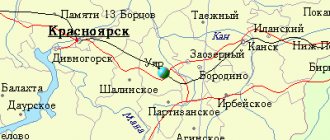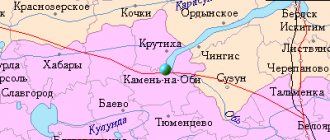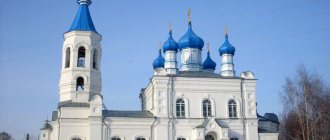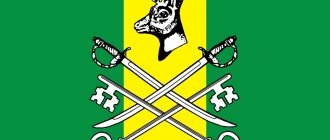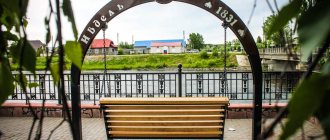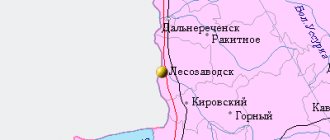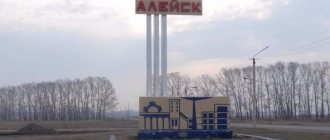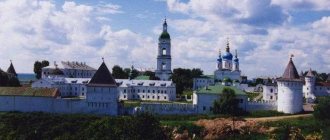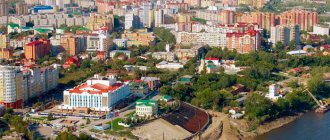The further an era goes, the less remains of it. Once upon a time, the whole country for decades in a single impulse built communism, but in the end all undertakings and aspirations were dashed against a completely different system, where man is a wolf to man. And just as the waves wash away footprints in the sand, so every year the memory of that time dissolves. And we are not only talking about spiritual and, if you like, ideological memory. The architecture that reflected the spirit of the time and era is being lost. Now, devoid of ideological background, it represents primarily a cultural value that we may not preserve. About the cultural heritage of Krasnokamensk, which is young by historical standards, in a conversation with Nadezhda Kurganova, a member of the Union of Architects of Russia.
History is the teacher of life
Soviet monumental art of the period 60-80s is usually called Soviet modernism. Yes, Krasnokamensk, the second largest city in Transbaikalia, cannot boast of the ruins of pre-revolutionary houses, battle sites or historical monuments of world scale. In 2021, our city celebrates a modest date - 55 years since its founding, so until now Krasnokamensk can rightfully be called a unique “Soviet” city. Once upon a time, specialists from all over the Soviet Union came to it, creating their own unique cultural heritage. But in Soviet times, no one thought to officially register, “certify” small forms, mosaic panels, Soviet “graffiti”.
— The content of all artistic objects was determined by ideological principles. The artist had to glorify communist ideals, the working man, the military feat of the Soviet people, world peace,” says Nadezhda Kurganova. — As a result, the monumental art of the late USSR is distinguished by its desire for stylization and simplification of forms. Let us pay attention to the Soviet traditions of shaping the urban environment, which left “traces” in Krasnokamensk, where many interesting monumental objects of the late USSR have been preserved. There are almost no examples of caring for them, of the desire to preserve them for posterity, so that even in a hundred years people can imagine what that time was like.
For example, the party leadership of the city decided to decorate the facade of the educational building of the building of the mining technical school (at that time GPTU No. 11) on the theme of science and thirst for knowledge. A talented artist, a graduate of the Stroganov School, Mikhail Trenikhin, and an architect Bugin took on the task of realizing the idea. This is how a high relief appeared in 1980 - the panel “The Road to Space”, where the six-meter figure of Icarus strives for the sun. There are even vertical sundials, which on a fine day can be used to more or less accurately tell the time. The overall composition is made of three-dimensional figures of forged aluminum and polychrome surroundings. For ocher, ground brick was mixed with plain cement, and for blue, blue cement was mixed with white and the addition of marble chips. Exclusively Soviet materials preserved the panels in their original form. And this is very good: people have the opportunity to come and immerse themselves in the era of “developed socialism.”
“No better or similar one has been created in recent decades. One of the most popular trends in monumental art in the USSR were huge mosaic panels, both on the facades of buildings and in interiors. Mosaics are perhaps the most spectacular and at the same time the most “vulnerable” part of the Soviet artistic heritage, says Nadezhda Kurganova. — Mosaic panels change the urban environment, but they themselves change. Most often for the worse: unprotected, they disappear, are destroyed, becoming a thing of the past.
For example, the fate of the facade of the first public center. The mosaic on the building is devoid of proletarian pathos with the inevitable hammers and sickles, banners and other communist symbols. Instead, there are dancing figures, symbolizing the energy of peace, creation, and warmth. Such a mosaic could easily decorate a building in any country in the world. Technical openings on the mosaic facade are mercilessly cut out, the mosaic frieze is covered with advertising, and some parts are destroyed and painted over. This is some kind of completely wild arbitrariness - to dismantle monumental heritage sites for the sake of commercial goals.
Why live here?
— my classmate Evgeny Kuznetsov says with bitterness in his voice. — I have a large family, I tried to engage in agriculture, but they didn’t let me. For three years I fought for the land allotted to me as a large family; I wanted to start farming. Finally, he knocked out a plot of land in the Mayak area, took out loans, and erected a temporary house. But there are no roads there, no transport goes there. I repeatedly appealed to the mayor of the city, referring to the decrees of our president, but received replies in response: there is no money in the budget, do everything yourself. There is no help for farmers at all.
Last year, I couldn’t go through a medical examination with my child for a sports section for a month - there are no specialists, and those who do have a waiting list for months in advance. I had to go to Chita, where the money was spent there in one day. I need to think about how to raise children, I myself am a retired disabled person, and we have no prospects for either work or business. I worked as a watchman for four thousand rubles - is this a way out? I stopped drinking and smoking a long time ago – I can’t afford it. Pulling out a child’s teeth is a problem; we don’t even have a place to sign up in line.
Mosaic of Krasnokamensk
But on the surviving unique examples of monumental mosaics in Krasnokamensk there is no poster canon of the stereotyped image of workers and peasants, the pathos of the builders of communism and the pathos of the era - they are all devoid of ideological background. For example, the facade of residential building No. 313, made by artists A. Abdumamonov, V. Tyutyunkov, S. Rudy, serves as a bright color accent among typical high-rise buildings. The city is growing, being rebuilt, updated, and everything that does not correspond to new tastes and goals is mercilessly destroyed; the new owners of the buildings, in the process of “European-quality renovation,” knock down monumental paintings from the Soviet period and change the decorative design. The Soviet monumental heritage must be preserved for posterity, given the persistent interest in the Soviet period.
How to leave
Now we decided to leave this city, we managed to sell the apartment (sold for a year) for 1 million 400 thousand. Everything was signed, we handed it over to the registration chamber, where, according to the law, the documents had to be prepared within five days. A month has passed - silence. Where are our documents? People walk around with a mortgage, pay fees to the bank, but have no documents in hand. Due to the fact that we waited a month, one of my children did not have time to go to study anywhere after school, and the other was not registered for school - we cannot get to the place.
Small forms
An interesting example of Soviet monumental art are small architectural forms. In close collaboration, architects and sculptors created works that continue to delight the eye today.
— A study of the modern appearance of Krasnokamensk allows us to conclude that there are very few examples of urban monumental art left in their original form. Without proper attention, these wonderful Soviet-era works may disappear. Preserving cultural heritage and striking works of monumental art gives individuality to the appearance of the city, again giving ideas that are significant in society and culture a long, “monumental” life,” explains Nadezhda Kurganova. — Group “Chess Players”, author: architect A. Zagvozkin, sculptor V. Petrov, located between houses No. 113 and No. 139 - the figures of chess kings made of metal plastic have been lost. Composition “Autumn” about No. 637, author - architect A. Zagvozkin. The stela “To the Krasnokamensk Pioneers” made of natural stone, installed in 1988 for the 20th anniversary of Krasnokamensk behind the Dauria House of Culture, architect Yuri Chupin, A. Zagvozkin and sculptor V. Petrov. The "Afghan Break" monument, erected in 1990 - a year after the withdrawal of troops - symbolizes the mutilated fate of the younger generation. If you look closely, you can see the stylized figures of soldiers - one shielding the other from the explosion.
And they
Gathered in the Irkutsk region, the city of Ust-Ilimsk. The town there is small, the size of our eighth microdistrict. There is nature, on the banks of the Angara. There is production - there is a battery plant, a chipboard factory, and something else. That is, there is work. Construction is not like ours - two houses cannot be completed, but they are being built at an accelerated pace - they have fulfilled the construction plan right up to 2021. They make roads. There they elected a new mayor and now they pray to him as if he were God - he began to raise the town. The apartments there cost - on average, a three-room apartment for 800-900 thousand rubles. There is also a clinic, and the hospital is located 25 kilometers from the city - in Cheremkhovo, but minibuses go there regularly. This is where we want to move...
Store carefully
The greatest concern is caused by “graffiti” - the “My Krasnokamensk” wall. After the collapse of the USSR, the viaduct connecting the administration building with the square was unfinished. The retaining wall remained unimproved for a long time. At the initiative of the city leadership, member of the Union of Artists of the USSR Eduard Davtyan and his assistants began painting this wall in 2005. The composition consists of several medallions, reflecting the entire cultural component of the city. The emblems show in graphic language the city's coat of arms, its sports, music, medicine, and school. At the ends of the wall there is a stylized panorama of the first photo of the city with the words of Mayakovsky: “I know there will be a city. I know the garden will bloom.” Time is not kind to painting. Moreover, the administration of Krasnokamensk made a hasty decision to overlay a mosaic panel on top of the unique design for Krasnokamensk. Now a group of enthusiasts led by Nadezhda Kurganova has sent a letter to the head of the city, Yuri Didenko, and the chairman of the city settlement council, Pyotr Bezborodov, with a proposal to certify the cultural heritage of Soviet times and, according to the city charter, to take it under protection.
Yuri Zhitlukhin
Krasnokamensk
In 1967, at the site of the future Krasnokamensk in the Trans-Baikal steppe, there was only one sign with the words of Vladimir Mayakovsky, reminding of the upcoming construction: “I know there will be a city. I know the garden will bloom"
. The lands of southeastern Transbaikalia are rich in valuable minerals. Krasnokamensk arose due to the discovery of a deposit of uranium-238. Not far from the place where the city will soon be located, in the Maly Tulukai valley, geologists of the Sosnovskaya expedition discovered a deposit of this chemical element in 1963, which was named “Streltsovskoe” and turned out to be the largest in Russia. The chief geologist of the expedition, Lidia Petrovna Ishchukova, who discovered the deposits, later recalled that it was a rare case when in May 1963 the largest uranium deposit was discovered, and in January 1964 the first mine was already laid.
In mid-1966, geologists conducted detailed exploration of the central and western sections of the Streltsovskoye deposit, and the Red Stone deposit was discovered. At the same time, reserves at the Tulukuevskoye field were preliminary explored.
In November 1967, the Minister of Medium Engineering Efim Pavlovich Slavsky ordered the transformation of the Western Mining and Processing Plant into the Priargunsky Mining and Chemical Plant, which was created on the basis of the Streltsovskoye ore deposit. Work began on organizing a new uranium mining enterprise. The date of creation of the Priargunsky Mining and Chemical Combine is considered to be February 20, 1968.
In 1967, military builders in the amount of 42 people arrived in Trans-Baikal land, and construction of the city began. Soon the first village for miners and geologists appeared - Oktyabrsky (it currently does not exist; the village was abolished by a decision of deputies of the Legislative Assembly of the Trans-Baikal Territory in 2014 due to excess background radiation).
The construction of the city began with a tent city. Builders arrived here from different parts of the Soviet Union: Kazakhstan, Ukraine, Kyrgyzstan, Leningrad, Moscow, etc. The architectural plan for the future of Krasnokamensk was developed by a group of architects under the leadership of Alexander Nikolaevich Nyrova and Galina Nikolaevna Nyrova.
The first inhabitants of the young city were miners, geologists and builders - most of them young people, from whom the first legends about the name of Krasnokamensk came. Some claimed that the “red stone” was uranium ore, others told a poetic legend about an eagle supposedly falling on the stones and staining them with its blood. But the real story of the origin of the city's name is much simpler. The fact is that in their searches geologists were guided by a rock where outcrops of red granite rock were observed. So they said among themselves: “You will get to the red stone...”. And it stuck. In addition, the name was an ordinary name for a city that should not stand out in any way among other similar cities that carried out their activities in particularly secret conditions.
On July 16, 1969, the village of Krasnokamensk was officially given the status of a city of regional subordination. In 1974, the Orbita television station began operating. In 1975, complexes with ore processing and mining enterprises, sulfuric acid and chemical plants, thermal power plants, a mine construction department, a mechanical repair plant, a research laboratory, motor depots and other facilities were put into operation. In 1976, the plant was awarded the Order of the Red Banner of Labor, and in 1980 - the Order of Lenin.
And in 1977, the Krasnokamensky district was formed, the center of which became the city of Krasnokamensk. It included rural settlements that previously belonged to the Argunsky and Transbaikal regions.
Today, the Priargunsky Industrial Mining and Chemical Association (PPMCU, established in 1994) is the city-forming and largest uranium mining enterprise in Russia. But not only uranium is mined here. The association is developing deposits of fluorite (fluorspar), necessary for ore smelting, and deposits of zeolite, called the mineral of the future. Not far from Krasnokamensk there is the Urtuyskoye brown coal deposit. Since 1989, coal from this deposit, which is of very high quality, has been used in the Trans-Baikal Territory and some areas of Primorye.
In 1980, a monument to the Transbaikal heroes who died during the Great Patriotic War was unveiled in the city. It is a pedestal with a T-34 tank mounted on it. On November 6, 1985, the Dauria Palace of Culture opened its doors - one of the most beautiful buildings in Krasnokamensk. In the same year, the largest residential building in the city was commissioned with 33 entrances and 640 apartments. In 1990, a monument to internationalist soldiers and fellow countrymen who gave their lives in Afghanistan was unveiled.
In 2007, Krasnokamensk was awarded the well-deserved title “The most comfortable city in the Chita region.” Every year the city becomes prettier and greener, and becomes more well-groomed. Parks and squares, wide avenues, fountains, landscaped courtyards, playgrounds, green spaces, huge flower beds and flower beds, stadiums and gyms, specialized complexes and swimming pools are united in the city into a single and harmonious composition.
Map of the city of Krasnokamensk. Krasnokamensk Yandex maps
Created using the Yandex service People's Map (Yandex map), when zoomed out you can understand the location of Krasnokamensk on the map of Russia. Krasnokamensk Yandex maps. Interactive Yandex map of the city of Krasnokamensk with street names, as well as house numbers. The map has all the symbols of Krasnokamensk, it is convenient and not difficult to use.
On the page you can read some descriptions of Krasnokamensk. You can also see the location of the city of Krasnokamensk on the Yandex map. Detailed with descriptions and labels of all city objects.
Share information with friends:
Realtor comment
“Many have put their apartments up for sale, our database of apartments is more than 600. Some are waiting, while others entrusted us with the right to sell and left Krasnokamensk,” says Christina, manager at Real Estate Agency No. 1. — The situation with the registration chambers is this: they signed a suspension of the production of documents, since the specialists went on vacation (there are only two of them). In general, the real estate market is reviving, there is an influx of mortgage buyers. So, not all Krasnokamensk residents are trying to escape from the city; some are making serious plans for life. Now it is profitable to buy apartments - prices are very low.
Yuri Zhitlukhin
Population of Krasnokamensk for 2021 and 2021. Number of residents of Krasnokamensk
Data on the number of city residents are taken from the Federal State Statistics Service. The official website of the Rosstat service is www.gks.ru. The data was also taken from the unified interdepartmental information and statistical system, the official website of EMISS www.fedstat.ru. The website publishes data on the number of residents of Krasnokamensk. The table shows the distribution of the number of residents of Krasnokamensk by year; the graph below shows the demographic trend in different years.
Links to official documents and resources on the population census are marked with a [*] sign; when you hover your mouse, you will see the title of the document.
| Number of residents of Krasnokamensk | Years |
| 56,000 people | 2005 year |
| 55,800 people | 2006 |
| 55,600 people | 2007 |
| 55,200 people | 2008 |
| 55,666 people | 2010 |
| 55,700 people | 2011 |
| 55,429 people | year 2012 |
| 55,418 people | year 2013 |
| 54,608 people | year 2014 |
| 53,795 people | 2015 |
| 53,242 people | 2016 |
| 52,811 people | 2017 |
| 52,299 people | 2018 |
Graph of population changes in Krasnokamensk:
The population of Krasnokamensk in 2015 was approximately 53.7 thousand people.
According to 2012 data, there were 35,866 residents of working age in the city. The majority of them were men - 51.4%. The average age of city residents was 35.7 years.
Ethnic names: Krasnokamenets, Krasnokamenets, Krasnokamenka.
